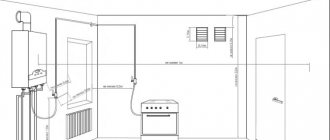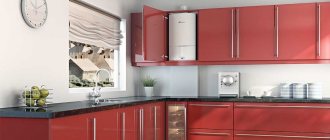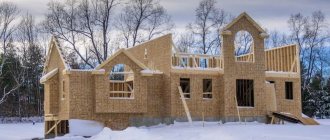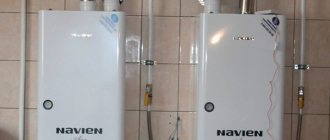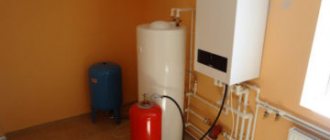Many people who own country houses or just summer cottages are seriously tormented by the question - what will happen to the house, its decoration, as well as all the installed furniture, if the house is not heated throughout the cold season? This raises another question - what is better for the house: to leave it unheated for the whole winter or to come there from time to time and heat the living quarters? This issue needs to be addressed. So, what will happen to your dacha if you leave the house without heating in winter.
Different parts of the house and furniture may react very differently to such a test. First of all, because different materials used in finishing, repair, and furniture manufacturing react differently to such tests.
Oil radiators
Attention: Among all types of heaters, oil heaters are considered the most reliable and safe. They consist of a sealed housing filled with oil and an electric heating element. All modern models of such devices have a thermostat designed to manually control the heating temperature of the device. High-end heaters are equipped with timers for programming heating and liquid crystal displays that display the current operating parameters of the device. Models equipped with a built-in fan heat the room faster and more evenly, accelerating the movement of convective flows and more intensively mixing layers of air with different temperatures in the room.
Oil radiator with liquid crystal display, equipped with a removable device for safe drying of clothes.
The body of the oil heater, depending on the type of unit, has the shape of a flat panel or a cast-iron central heating radiator - it consists of separate sections assembled into a battery. The more sections there are in such a device, the more intense the heating of the room will occur. The capacity of the radiators of different models of oil heaters may be different - you can increase the heat transfer area of the battery by changing the profile of the sections while maintaining the main dimensions of the unit.
This heating equipment has the following advantages:
- simplicity of design;
- noiselessness (models without fan);
- affordable price;
- presence of automatic control;
- safety.
Among the disadvantages are increased energy consumption and low speed of entry into operating mode - the result of the heater will be felt no earlier than 30 minutes after switching on. In addition, it is worth mentioning the fairly significant weight of oil radiators - from 18 to 25 kg.
How will wooden furniture and decoration react to wintering?
Another question of interest to dacha owners who decide to leave their country homes without heating for the winter is what consequences such wintering can have for wooden furniture and decoration. The question is very relevant, so it is worth answering it in detail.
As mentioned above, wood coated with varnish or paint is reliably protected from temperature changes and, accordingly, humidity changes. Unprotected wood, regardless of its species, absorbs moisture when air humidity is high and releases it when the ambient temperature drops. Some wood species, whose wood has a higher density, are less susceptible to this, others more so. But a similar process occurs with any wood, which is why it is called a breathable material.
When the ambient temperature drops, the wood begins to release moisture. Of course, the closer to the surface, the more intense this process is. And when drying, wood tends to shrink due to the fact that the surface has already given up moisture and, therefore, has decreased in volume, but the core has retained the same moisture content and size, and fiber rupture occurs, that is, cracks appear.
The more often changes in temperature and humidity occur, the higher the likelihood of such defects appearing on your wooden furniture, stairs, railings and floors.
Conservation of the construction of a brick and block house
Such buildings also require conservation. The degree of moisture protection required depends on what blocks were used to build the walls. For example, a gas block without a roof is extremely sensitive to moisture. Therefore, block walls should be covered with waterproofing material along the entire perimeter. This is necessary so that precipitation does not moisten the building too much, which will protect it from destruction.
Many conservation experts recommend treating blocks or bricks with antiseptics. For example, you can use water repellent Neogard or Aquastop. Silar is well suited for aerated concrete, brick and many other building materials. Aerated concrete and artificial mineral stone will help protect Penta 820.
In addition, there are many other high-quality products that can be used to preserve an unfinished house made of aerated concrete, brick or blocks. The use of an antiseptic is recommended when preserving construction at any stage.
Shutdown rules
The shutdown procedure is individual for each brand of boiler unit, but in general it has common stages. The manufacturability of the process of stopping the unit depends on the purpose and design - single-circuit or double-circuit devices. The shutdown of a double-circuit boiler for the summer period will be partial, that is, the heating equipment will be turned off, and the DHW load will continue to function.
General steps to shut down the unit:
- Turn off the gas valve. There are 2 options - only for the main burner or together for the main burner and igniter.
- In the first case, the handle is turned clockwise and set to the “ignition” position, while the main device will be turned off, but the pilot will continue to function.
- In the second case, the knob is turned clockwise to the “off” position, which will shut off the gas to all burners.
- You can turn off the auxiliary equipment, fans and smoke exhausters, 15-20 minutes after shutting off the gas.
- Stop the circulation pump after the network water has cooled to room temperature.
- Turn off power to the device.
- Preserve the unit according to the manufacturer's instructions.
- Switching off a double-circuit unit in the summer follows a slightly different procedure.
- First, the heating line is closed with a three-way valve; in this case, the coolant flows from the heating system into the secondary hot water boiler.
Turning off the gas boiler begins by turning off the gas valve
In case of severe frosts
Frost poses the greatest danger to a residential building, and especially to water supply and heating systems.
Since I left the house without gas heating, I had to drain the system. I did this using the boiler pump, then disconnected the pipes and blew them out with a compressor. When I was doing this procedure, the thought came to me - pour antifreeze into the heating system and forget about all the problems. But I didn’t risk doing this because I don’t know how antifreeze will behave in a heating system. If anyone uses anti-freeze in their heating system, please write the pros and cons of this method.
I did the same with the water supply. I disconnected the water line and drained the water from the pipe. In the internal water supply system, I also removed water with a compressor. I drained the water from the toilet tank, dried it, and treated the tank fittings, especially the rubber parts, with aerosol silicone lubricant. This was done so that the rubber did not dry out and the mechanism remained in good working order.
Since the temperature in the living room cannot be lowered to negative temperatures, the house had to be heated with oil-based electric heaters. More precisely, not to heat, but to maintain a positive temperature. The oil heater has no exposed heating elements, is relatively safe, and can operate for a long time without supervision.
I bought two heaters and placed one in the living room and the other in the hallway. I’ll say right away that I bought expensive devices. When it comes to safety, it is better to pay more and buy a quality item.
I left the internal doors in the house open and blocked the ventilation shaft so that the heated air did not escape from the room. I set the heaters to 70% power to prevent overloading the device or network. The furniture was moved 15 cm away from the walls, electronics and household appliances were unplugged from the sockets and covered with cellophane film.
Fan heaters
The main advantage of fan heaters is their compactness and the ability to quickly heat the room. An electric fan heater consists of a heating element and a fan.
Important! Fan heaters, depending on the power of the model, can be used to heat both residential premises and large industrial facilities of a large area, for example, warehouses or hangars.
Household fan heaters are easy to use and compact. Their cost and quality depend on the type of installed heating element, which is used:
- spiral;
- heating element;
- ceramic type heater.
Portable compact fan heater Timberk in a plastic case
The main disadvantages of spiral fan heaters are also the increased consumption of electricity and the high heating temperature of the spiral - when dust gets on the spiral, it burns, emitting an unpleasant and harmful odor to humans.
Non-electric heaters
All of the heaters listed above require electricity to operate. But in the absence of power supply, the need for heating does not disappear, and in such situations a gas convector is indispensable. Such devices are distinguished by their heating efficiency, durability and reliability. Household gas produces almost no harmful substances when burned, so there is no need to install a hood in the room. However, gas combustion is accompanied by the consumption of oxygen from the air, and the heated room must be periodically ventilated.
The gas convector is equipped with devices for automatically stopping the gas supply when the burner goes out (flame sensor), gas pressure surges in the supply or the device overturns.
Household portable floor-mounted gas convector with protective grille
Infrared heaters operating on reduced gas (propane, butane) or diesel fuel (models with combustion products vented outside) have also proven themselves to be excellent.
To heat rooms, you can also use more powerful devices - gas guns, but they are used more often in industrial buildings, where people are not present constantly, but periodically. However, even in such a situation, fire safety is the factor that occupies first place in the requirements for the operation of such equipment.
Of all the heating devices listed above, the safest are oil heaters and electric convectors. But, no matter what heating device you buy, during its operation there is always a factor of increased temperature of the equipment body and the danger of a fire or burn. Therefore, you should always remember safety precautions and strictly follow its rules. The type of heater you use will only determine which safety priority you prioritize.
In addition to the general rules for the use of electrical or gas equipment, individual requirements set forth by the manufacturer in the instructions for use are mandatory.
Which boiler is the easiest to maintain?
The easiest thing to maintain is an electric heater. The worst thing that can happen to it is software problems, which can be easily fixed through computer diagnostics. All other boiler equipment requires periodic maintenance, checking and cleaning of chimney pipes. The most difficult thing to care for is a solid fuel boiler. Here, cleaning the chimney and heat exchanger should be done annually, and in some cases even several times a year. In this case, after each use the ash pan must be cleaned. In addition, when installing such a unit, it is necessary to provide in advance a dry and sufficiently large room for fuel storage. To heat a medium-sized cottage, about 15 cubic meters are required. firewood in season.
Why is it safer to warm up the house?
If you make mistakes when preserving your home, you may experience burst pipes in the room. In this case, you can lose furniture, interior items, and household appliances. Most often, pipes are hidden inside, so finding and replacing the required section will not be easy and may result in serious repairs to the house.
Without waiting for the weather to warm up, you can open the summer season earlier and start using water supply and sewerage. No re-preservation is needed.
Experts recommend heating buildings. A heated house will serve its owner longer and will not require major repairs. Modern equipment allows you to regulate the temperature and monitor what is happening in the house from any distance.
Dial City Adimari
The book is a bestseller of 2022
Post-apocalyptic novel “Dial. City of Adimari" will plunge into the universe of bloodthirsty Kumo demons, immortal Lyonites and metal werewolves. When the familiar world collapses, the main thing is not to lose faith in yourself...
In general, the smart home system has become available not only to very wealthy people, but also to those with an average level of income. If you decide to go outdoors in winter, you won’t have to spend a lot of time warming up the room. When the house is empty, you can maintain a minimum temperature, and before arrival, warm it up to a comfortable temperature for a person to live in.
What heaters can be left unattended - Dachny Mir
When purchasing a device for heating your home, you need to pay attention not only to the technical characteristics of the unit, but also to the safety of its use.
To choose the safest heater, you should evaluate the degree of its fire safety, in the presence of the oxygen consumption factor - its intensity, the heating temperature of the housing and other parameters.
After all, for example, if the heater body gets very hot during operation, you can get burned by accidentally touching the device. One of the first places when choosing a heater is also the degree of environmental friendliness of the device - a particularly important characteristic if a child lives in the house.
Types of heaters
Heating systems that are installed in suburban areas are, as a rule, ordinary fireplaces and stoves. But if it is not possible to constantly monitor the operation of such heaters and the country house is not used as a permanent place of residence, such devices are unsafe. What heater should I buy for my dacha if it is rarely visited? It is worth considering options such as:
- Oily;
- Fan heaters;
- Heat guns;
- Gas or electric convector;
- Infrared;
- Quartz;
- Electric fireplaces.
See also -
Which heater to choose for the garage
Installation or mounting methods
In domestic premises, only three installation options are used:
- fastening the electric convector with brackets to the wall;
- wheels on legs - for convenient placement and movement around the building;
- only the decorative grille remains in a visible place, and the entire body is hidden under the floor;
- combined mounting method - there are brackets for hanging on the wall and removable legs.
Most often, the first type of installation is used in apartments. Here, space is already limited, which means the wires will not get tangled under your feet. Moving a household appliance around the building adds mobility to this solution, and discreetly placing the housing in the floor is a very unusual, but effective approach to installing a heating system.
But, of course, universal electric convectors are called that because they combine the characteristics most demanded by consumers. Although floor-standing appliances are deservedly popular.
There are several ways to install a convector
Oil heater
This device consists of several flat sections filled with mineral oil, which looks like a battery.
Inside the device there is a heating element that heats the oil, thus heating the room.
Oil heaters come in the form of a solid panel, however, its only advantage is its aesthetic appearance; it heats the room less efficiently.
The advantages of the device are its energy efficiency and affordable price. And most models are equipped with an emergency shutdown function in case of a fall.
Despite the fact that it takes a lot of time to completely warm up the room, the heat will not go away for a long time even after the device is turned off.
The main disadvantage of an oil heater is that it heats up to 90 degrees, and it is unsafe to keep it in a house where animals or children live.
Criterias of choice
We've sorted out the types of convector, now let's move on to studying the important characteristics that may influence your choice.
Room area
The area of the room for which it is designed is written on the packaging of the device. Typically this ranges from 5 to 100 square meters. Please note that this area is indicated with the expectation that the device will be the only source of heating. That is, if your batteries are running low, then you don’t have to buy too powerful equipment.
An important nuance is minimizing heat loss. Think about it, maybe before buying a convector you should insulate the walls and minimize the gaps in windows, doors and ceilings? You will save significantly on the monthly use of the device.
Power
There could be a lot of technical information here, but it’s better to write the basic principles and recommendations in simple, understandable language:
- do not buy a device according to the principle “expensive means good”; in this niche, the price is usually determined by high power and additional functions;
- the required power of the device can be calculated using the formula - 1 square meter = 100 W (if your walls are poorly insulated and there are no other heating sources, then the formula changes - 1 square meter = 150 W);
- Electricity consumption depends on power, so if you want to save, choose models up to 1 kW;
- take into account the load on the wiring - for the most part, this applies to “Stalin” ones, where when the refrigerator, washing machine, computer and convector with a power of more than 2 kW are turned on, plugs will definitely be knocked out.
Mounting method
Consider not only how the convector will fit into your interior design. Safety also plays a big role. Are children injured? Will your indoor lion turn the device over? Why don't you catch the device yourself when you go to the toilet at night?
There are 3 ways to mount the convector:
- On the wall. Suitable for children's rooms, kitchens and places where you want a heat source that will not take up space on the floor.
- On the floor. Mounts on a bracket or stands on wheels. A common option in living rooms, bedrooms, and offices with partitions.
- Embedding. Can be mounted into the floor or window sill. A convenient option for greenhouses, houses with panoramic windows, shopping centers and swimming pools.
Thermostat
There are mechanical and electronic. The first one is cheaper, the second one maintains a more accurate temperature. An electronic device will be needed when installing it in a pharmacy, plant warehouse, or somewhere else where it is important to maintain certain storage conditions.
Hole location. They can be located:
- on the side - there will be less smell of burning when turned on;
- on top - provide good air permeability, but are more susceptible to dust settling;
- in front - the wallpaper will not fade;
- on the inclined surface of the front part - suitable for a nursery or bedroom.
Dimensions
The device should not interfere. A convector measuring 50-80 cm is suitable for a bedroom or living room. For a kitchen – 40-50 cm. It makes sense to install appliances larger than 100 cm only if you are going to use them as the main heating.
Weight
Many people think that it is better to choose lightweight floor convectors to make them easier to transport. It sounds logical, but you need to understand that lightweight appliances are easier to knock over. The optimal choice for installation on the floor is 3-5 kg.
For wall mounting – 8-10 kg. Select gas convectors based on the thickness and material of the wall. The main thing is that it can withstand the load.
Fan
Its presence accelerates heat transfer. If you have an elongated rectangular room, this is what you need. The fan is also extremely important for water convectors near panoramic windows. It will protect the glass from condensation.
Housing protection
This is marked on the case with the letters IP and numbers nearby. The first number (usually two) is not interesting to us. Let's pay attention to the second one. She talks about the compatibility of the device with a location near the water. If the second number is 2, then the convector is designed for dry rooms, if 3 – it can be used in the kitchen, 4 – it can be safely used in the bathroom and rooms with high humidity.
Fall protection
Yes, there are convectors with rotation protection. If the position changes, the convector turns off. This point is especially important if you have children who love active indoor games or pets.
Less important parameters
The parameters may be less important, but they can still make your life a lot easier. The comfort and ease of use of the equipment depends on them. And there will be something to brag about to your friends - “Do you know what my convector can do?”
Ionization . The function helps clean the air from fungi and all kinds of bacteria. You will be surprised when you smell the forest - it's all the work of beneficial ions.
Timer. An ideal feature for people with a busy schedule. With it, you can program the convector to turn on 30 minutes before you wake up in the morning. Imagine you wake up and the room is warm. And I didn’t have to leave the device turned on overnight for this.
The same goes for turning off the device. Set a timer and go to bed. The device will turn off automatically.
Modes. Modern convectors allow you to set modes with which you can set the desired temperature in one click. Do you want to quickly heat up a room or maintain an economical mode? All in your hands.
The antifreeze mode is especially useful. If you need to leave home for, say, a week, the device will be able to maintain a temperature of up to 10 degrees so as not to freeze. Moreover, it will react automatically. All main modes will be disabled.
Fan heater
Source: https://drova-pil.ru/vidy-otopleniya/kakie-obogrevateli-mozhno-ostavlyat-bez-prismotra.html
How and why does furniture dry out?
Dry railings
Now we can roughly understand why furniture is drying out. Furniture dries out because moisture comes out of it. Evaporates. The components that make up the furniture shrink, dry out, and gaps may form between the pieces. Notice! In order for a thing to dry out, it only needs to freeze and stay in a cold house for a while. Whether you heat your house periodically or not is the second question.
But why does furniture dry out? Because it is made poorly. For example, it is made of wood, which expands very significantly when wet and shrinks just as significantly when dry. Or maybe the furniture is not painted or varnished? Then it will absorb well and dry well and dry out. I had a cute wooden flower stand. It was made in an antique style and was decorated to look like mahogany. Time passed, the varnish evaporated somewhere, and after many years of faithful service the thing dried out completely. On the one hand, it’s a pity, but on the other, it’s his own fault. It was necessary to update the varnish.
When furniture is made with high quality, the boards are carefully selected according to their pattern and structure. A strict selection of materials is used to check for knots and other defects, high-density wood, high-quality adhesives, varnishes and paints are used, and so on and so forth. Such furniture does not dry out. But it also costs a lot of money. This also seems understandable.
Preservation of building materials in winter
At any stage of construction, there may be materials on site that will find it difficult to withstand a harsh winter. Therefore, you should use the recommendations of specialists to eliminate the possibility of damage.
Lumber is stored in stacks. Roofing and waterproofing materials should be folded under the roof or covered with film. It is important that they are kept in a dry place. All paints and antiseptics should be tightly closed. Otherwise, they will dry out or erode, after which they will become unsuitable for further use. Bulk materials such as cement, alabaster and lime should be removed from the street. They must be stored under special conditions. It is advisable that the room is not too cold and dry.
What rules must be followed?
When carrying out measures to preserve boilers in production, they are guided by the requirements set out in RD 34.20.591-97 “Guidelines for the preservation of thermal mechanical equipment.”
The same standards should be observed by owners of equipment installed in private homes.
If you are not confident in your knowledge or skills, contact your service organization. Specialists will carry out work to shut down the boiler and preserve the equipment in compliance with all safety requirements
What you need to remember if you decide to mothball your heating or hot water equipment yourself:
- Before any repair work, the gas must be shut off. The main valve is installed at the gas pipeline entry into the house.
- Even the slightest ingress of oxygen into the system will cause corrosion of boiler parts and pipelines, so you need to choose one of the preservation methods and follow it strictly according to the instructions.
- When working with chemical reagents, you must protect your body parts with thick clothing, wear comfortable shoes, gloves and a mask.
- To keep the pipes and components of the unit in working condition, it is necessary to observe the dosage when diluting concentrated compounds and dry chemicals.
- Work with explosive or flammable substances may only be carried out by specialists.
- Upon completion of work, it is necessary to turn off the power supply to additional equipment - for example, a pump.
The above rules must be followed to protect your own health and preserve the equipment.
After a long period of inactivity, the heating and water heating system will require re-preservation - a process that also requires compliance with certain rules.
What boiler equipment maintenance procedures can you perform yourself?
On average, boiler maintenance procedures need to be performed once a year. The only thing the user can do himself, without risking the stability of the device and his own safety, is to wipe the device body with a damp cloth. An expert is required to carry out the remaining work. His responsibilities include performing the following tasks:
- Fuel supply regulation.
- Checking control and safety systems.
- Cleaning the burner and heat exchanger.
- Checking the operation of electronics.
Methods for preserving gas boilers
Let's consider the main methods of preserving heating equipment, but with one caveat - not all are used in home maintenance. Some of the methods are more suitable for equipment installed in production plant workshops.
For home maintenance, alkalis are used - caustic or soda ash. It is not recommended to use acidic reagents on your own; hydrochloric or sulfuric acid can only be used by qualified specialists
The process of preservation of the heating circuit is preceded by a preparatory stage, which includes several points:
- Disconnecting the boiler from the gas main and central water supply, installing plugs. If water is supplied by the pumping station, the pump stops.
- Removing water or other coolant from the system.
- Cleaning internal surfaces from scale.
- Washing boiler parts and circuit.
Professional cleaning of calcium deposits can only be carried out by specialists - and the service organization has such a service. There are two most effective and simple ways to remove scale - chemical , mechanical (manual cleaning), but the first is recognized as the most effective.
The internal parts of the boiler, on which large deposits have appeared, are ground with a power tool, and scale in hard-to-reach places is removed manually, with brushes or scrapers.
Method #1 - dry stop
Dry preservation is carried out in production, usually for maintenance activities or during routine inspections, when it is necessary to stop production for up to 30 days. It consists of completely freeing equipment and pipelines from liquid and further drying.
The procedure is called "dry stop". It is applicable to any models of boilers, regardless of pressure, but is contraindicated for units in which the drums are connected to the pipeline with rolling connections
Procedure:
- Natural coolant cooling.
- Stopping the boiler.
- Displacement of liquid under pressure of 0.8-1.0 MPa.
- Drying the system naturally or by ventilation.
- Installation of trays with desiccants in the collectors - quicklime or calcium chloride grains.
- Closing the firebox and flue, plugs - complete sealing of the system.
At home, water is drained through special taps installed at the bottom of the pipeline. Then they carry out repair or maintenance work and leave the equipment in a “dry” state until the next heating season.
The drain valve is a shut-off valve that must be installed when installing a heating system. Most often, brass models are used, selected according to the diameter of the pipe.
The circuits are refilled with coolant using a pump. The heating function is activated only after the pipeline has been completely filled with water, circulation has been checked and diagnostics have been carried out.
This method is the only correct one if it is necessary to stop the boiler operation for the winter or for an even longer period.
Method #2 - wet preservation option
I use wet preservation if I need to stop the boiler for a short period. The main goal is to keep the equipment in working condition, protect against corrosion, and prevent oxygen from entering the circuit.
To fill pipes at home, a special liquid is used that prevents the formation of rust. It is sold in specialized stores in concentrated or ready-to-use form.
For regions with severe frosts, liquids that do not freeze at low temperatures are used. For example, concentrated antifreeze is in a liquid state down to -60 °C. To prevent the substance from thickening, it is diluted with water. But we must remember that the freezing point of an aqueous solution increases.
Antifreeze has other disadvantages:
- “eats” rubber;
- has a high degree of fluidity;
- cannot tolerate overheating - turns into acid;
- expensive.
Instead of antifreeze, use a solution of sodium sulfate at a rate of 10 g/liter of water. The liquid poured into the system is heated to displace the air, and then all holes are hermetically sealed. A pressure test pump is used to pump water into the circuit.
Method #3 - gas preservation
For private houses, the gas preservation method is not used, since this requires special equipment and professional skills.
The essence of the technology is that gas is released into the pipes, which, when in contact with metal, unlike oxygen, does not cause corrosion. Such gases include argon , ammonia , helium , and nitrogen .
Some types of gas are hazardous to health, and without following safety regulations, you can easily get poisoned or get burned. All procedures are carried out strictly according to the instructions and in protective clothing.
The conservation process is complex and is carried out in several stages:
- the system is washed with deaerated water;
- connect a gas cylinder and a pressure reducer;
- fill the circuit with gas, displacing water;
- close the drain valve;
- when the indicator is 0.013 MPa, the gas supply is stopped;
- close the pipe, turn off the cylinder.
The main condition for gas preservation is the absence of air in the system , so throughout the entire period of inactivity it is necessary to monitor its tightness.
Method #4 - applying excess pressure
High-pressure preservation technology is usually used in enterprises where all conditions are created for this. It is used for water heating and steam equipment.
The main task is to prevent oxygen from entering the system. To do this, a pressure above atmospheric is created inside the circuit, while the usual coolant is replaced with deaerated water
The overpressure method is suitable if it is necessary to stop the operation of a gas boiler for a short period of time - up to 10 days. Typically, during this period, repair work not related to water heating equipment is carried out.
Preservation of a frame house at the stage of roof construction
Frame houses have one good feature - they are quickly built. However, the weather may be too unpredictable and the craftsman will have to postpone the construction of the building for a while. If the house already has a roof, then preserving the frame house should not cause any difficulties. Otherwise, experts recommend making a temporary roof. To do this, rafters, sheathing and waterproofing, for example, roofing felt, are laid. Afterwards everything should be securely secured with slats.
The next stage will be the conservation of window and door openings. It is advisable to cover them with boards or metal sheets. Afterwards, you can use a special protective film that will protect the room from excess moisture.
In winter the weather can be different. In spring there is more moisture, so at the canning stage it is necessary to consider a drainage system. Otherwise, it is possible that flooding will begin when the snow melts. By preparing the grooves in advance, you don’t have to worry about a spring flood.
Wintering a house without heating. Harmful or not?
Actually, it's harmful, of course. For two winters in a row, we have left our rural house “to the mercy of fate,” as we bring our father to our city for the winter. In the summer he lives in the house.
If you leave the house without heating, in the spring it is advisable to whitewash all the walls from the inside, as they may begin to mold in some places. As many things as possible should be taken out for the winter (especially clothes, books, any liquids in any containers, as well as anything that could be stolen). If you leave mattresses and blankets for the winter, in the spring they should be dried in the open sun for at least one day.
The electricity must be turned off at the panel!
And the house also needs to be insured.
An elderly grandfather and grandmother died in our village. The relatives could not agree on a price and began to sell the house, which was then in good condition, for 1.8 million rubles. The tenants were not allowed in because they were afraid that they would ruin everything. A year later, when the house stood all winter without heating (they couldn’t agree on who would pay for the gas and cut it off so that the debt wouldn’t accrue), cracks appeared on the walls near the windows. The price became 1.3 million rubles. After another winter without heating, the cracks became larger, and the price accordingly became 800 thousand. A year later, one wall began to collapse and the house was sold for 300 thousand. The house is made of sleepers, lined with brick. So we draw conclusions about whether the house can stand without heating in winter. If you don’t mind the house, then maybe. If you need to preserve it, then it is better to let in your friends, conscientious, decent tenants who will pay for gas and the garden will not be overgrown with weeds.
